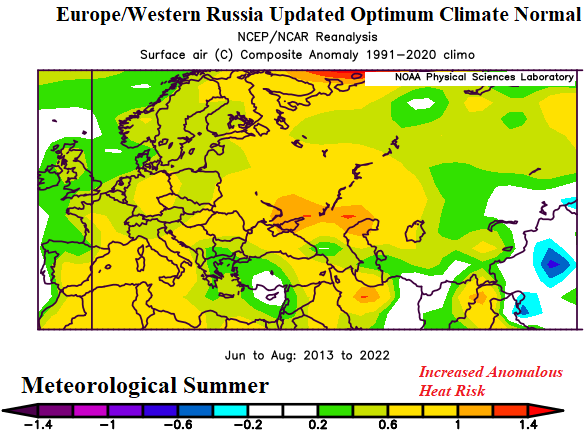
A Look at Summer U.S. and EU/RU New Optimum Climate Normal
05/21/2023, 8:57 am EDTUnique Synoptic Weather Pattern Causes Flash Fires in Canada
06/11/2023, 11:07 am EDT
Fig. 1: Global SSTA analysis and identification of ongoing marine heat waves and oceanic warm holes.
Discussion: Marine heat waves (MHW’s) and oceanic warm holes are not new. However, their presence, intensity, and persistence has intensified during the past 10 years. The destructive influence of MHW’s on the ecosystem in the Northeast Pacific and waters surrounding New Zealand is well documented. The influence on climate is less understood. However, Climate Impact Company has noted an increasing tendency of the upper air pattern across and downwind of MHW’s to produce amplified upper-level ridge patterns while regional cool pools (referred to as warm holes due to the surrounding oceanic warming) to run parallel with upper trough regimes. There are many examples during the past 10 years of these amplified ridge/trough patterns causing extreme climate and weather.
Currently, Climate Impact Company (and other government/research centers in the U.S. and New Zealand) are monitoring 5 MHW’s (Fig. 1). MHW NEP22A in the Northeast Pacific has weakened slightly although shifting eastward toward the West Coast of North America. NEP22A is one of the longest running and most intense MHW’s in the 1982-2023 climatology. A new MHW off the Northwest Coast of Africa has shifted west. In its wake, the Mediterranean Sea SSTA pattern has cooled dramatically, and that energy release to the atmosphere has caused historic storms in Italy and vicinity. In the southern hemisphere, the long-standing New Zealand MHW roars on maintaining a destructive influence especially on South New Zealand marine life. The Argentina MHW has shifted east and weakened slightly. A new MHW in the Southwest Indian Ocean has shifted east. Note the obvious influence of MHW’s on the upper air pattern as semi-permanent upper-level high-pressure ridge areas are located across and downwind the warm ocean surface in both hemispheres (Fig. 2-3).
Also significant, although not as plentiful, are oceanic warm holes caused by rapid ice melt in the polar region creating a stratified cool SSTA regime on a semi-permanent basis south of Greenland and southwest of South America. Typically, the atmosphere aloft and an upper low-pressure trough persists in these cool water zones.
The MHW and warm hole SSTA patterns are well-correlated with local/regional upper ridge/trough patterns. Because the atmosphere is in a constant state of compensation, amplified ridge/trough patterns downstream/upstream from the ocean regime-driven upper air dramatics are common.

Fig. 2: The northern hemisphere APR/MAY 2023 upper air trough/ridge pattern runs parallel to location of marine heat waves and oceanic warm holes.

Fig. 3: The southern hemisphere APR/MAY 2023 upper air trough/ridge pattern runs parallel to location of marine heat waves and oceanic warm holes.
